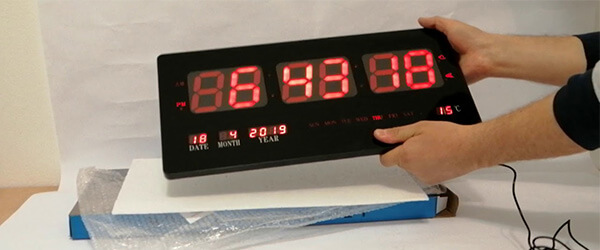“As an Amazon Associate, I earn from qualifying purchases. Without Any Extra Cost to You!”
Our ascension to the digital world has bestowed a myriad of blessings in our lives. However, when a simple digital clock fails to show us time accurately, it becomes very difficult to digest. But don’t worry as you don’t have to throw away your old clock right away if it’s running faster than usual. Because there are some easy quick fixes that I am going to share with you to solve this annoyance.
Having a digital clock that runs fast can still work for you, but you must do a few adjustments. Handling a clock with such an issue could be simple as walking into the park.
Possible Reasons for a Clock to Run Fast
A digital clock can run faster than usual for a variety of reasons. But these are the most common causes behind the issue:
- Electrical interference from outside sources can influence your digital clock. The Quartz crystal oscillator is responsible for setting the frequency of a clock. Its function can get disrupted due to outside interference.
- Motors operating the hands of a clock can be the reason behind a clock running faster than actual time.
- The digital circuitry can get damaged and start malfunctioning to show improper time on display.
Troubleshooting digital clocks that run fast

Step 1: Adjust an external Pendulum
Use either of your hands (non-dominant one) to grasp the pendulum. Access a tiny screw, situated at the pendulum’s bottom tip.
This small screw plays a critical role in controlling the speed of your clock; so once you access the Pendulum, you’re ready to go.
Now, use your dormant hand’s fingers to firmly rotate the regulatory screw. When you spin the screw to the left, it will slightly lower the pendulum, eventually slowing down the clock.
Remember, making each screw turn will slow your clock by two mins per 24-hour period.
Compare your adjusted clock to a reliable timepiece several times per day. You are supposed to make non-stop adjustments until your digital clock shows the correct time.
Step 2: Adjust an internal Pendulum
On the top of the digital clock, try locating a tiny hole. You are likely to encounter words like ‘slow’ and ‘fast’ surrounding the hole to lead you in adjusting the speed of the clock.
Get a double-ended key and insert its narrower end to the hole. Rotate the key firmly to the left; it’s limited to this but follow the direction stipulated on top of the clock. Turning the Key in this direction will probably slow down the clock.
Remember, making a complete revolution will slow your clock by 2 mins per 24-hour period. Compare the adjusted clock to a reliable timepiece several times per day. You are supposed to make non-stop adjustments until your digital clock shows the correct time.
Step 3: Adjusting an electric clock
It’s possible to reset the time on either a battery-powered or non-mechanical clock to fit an accurate and reliable timepiece.
You need to be very keen to observe your clock time for 24 hours. Doing so will make sure that your clock operates and shows the correct time reading.
Plugin your clock to a different power outlet in a different room and monitor the timing for at least 24 hours. This action is necessary because the initial outlet could be providing insufficient electricity to your clock.
Alternatively, if you own a battery-power clock, replacing the batteries could be the best option and solution too.
If it happens that after trying all the above steps and your digital clock still runs fast, take the device to a trusted repair shop.
This could be the best treatment to offer your digital clock because an experienced electrician is capable of determining extra problems that are out of your sight.
Besides, such folks have special tools and experience to determine a certain issue like a broken or faulty motor. Once the problem is identified he can then efficiently fix or replace the problematic parts.
Frequently asked questions about the digital watch
Is it possible to set up a quartz watch?
Yes, in fact, they are much easier to fix compared to mechanical watches. You can repair quartz movements using different cases.
Among those cases, where you require spare parts, try to always use suitable and reliable replacements from the same Company. With such spare parts, you will only have to swap the faulty part.
What may cause my digital clock to run slow?
Magnesium could make your watch run slowly or completely stop. However, generally, the clock should run a bit fast.
Additionally, tangled coils could be another reason why your clock is running slow; it could jolt the clock’s movement. Although this issue won’t adversely affect the speed of your watch like magnesium, you shouldn’t overlook it.
Why do clocks lose time after putting it on?
A bad battery may make a watch to lose time after wearing it. Atomic clocks that are synchronized to Atomic models are the most precise and almost don’t have clock drift.
In case the Atomic watch with you loses time, you may be forced to take it to an experienced technician for a check, repair, and maintenance.
Can I turn my clock backward?
Forcing your watch may destroy its mechanism; you would rather avoid this temptation. Watches that can’t be backset should be set by spinning the minute hand to only a clockwise direction.
But if you own a striking clock, back setting it might be tricky. Therefore, you should always stop at every striking point, approximately a half or one hour.
Final words
Well, here we are after a long journey; but not in vain. At least you now have the knowledge on how you can fix your digital clock that runs fast. Use the above tricks and stay up-to-date. The steps are simple and you are required to take your clock to an experienced expert for repair and maintenance.
